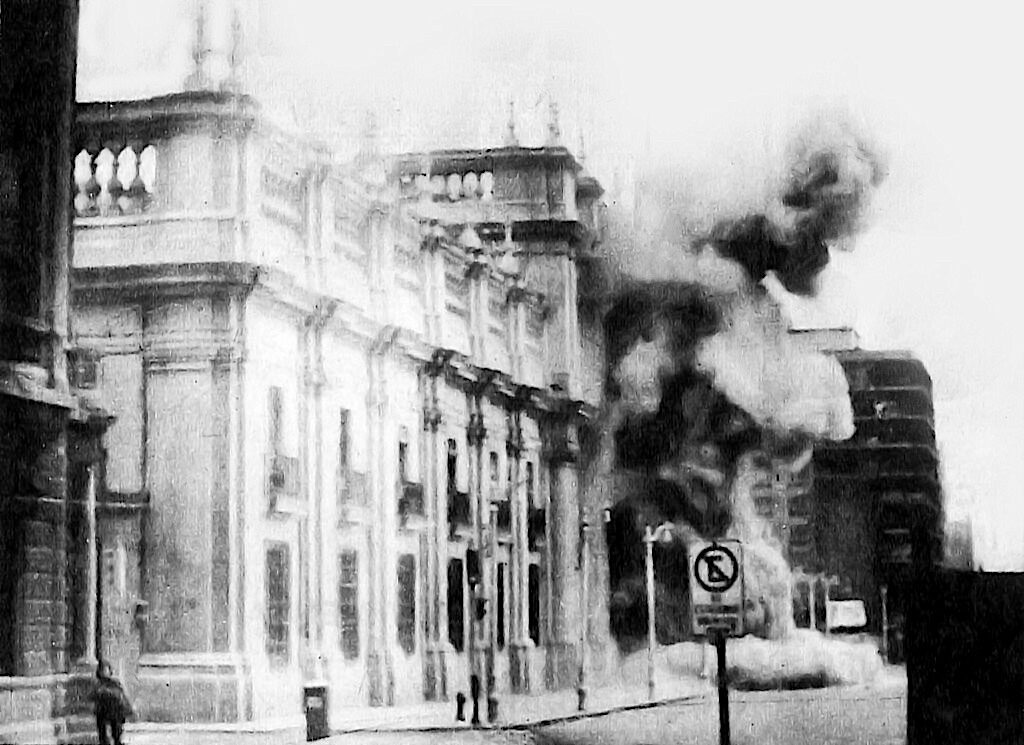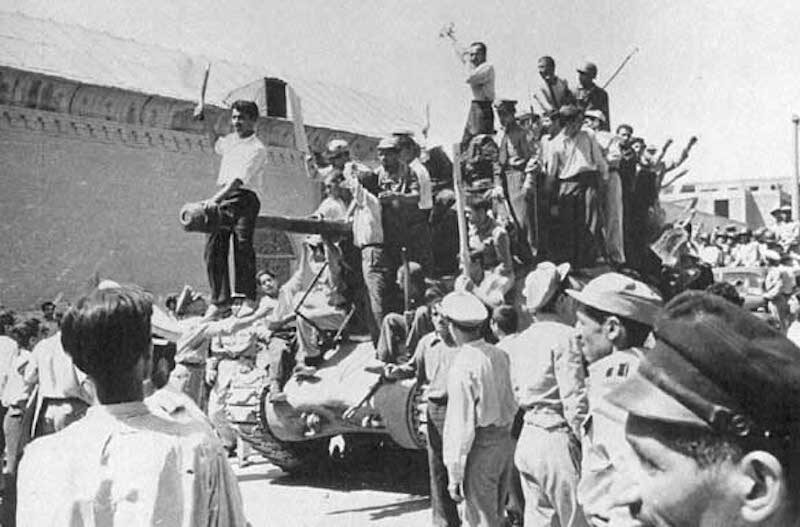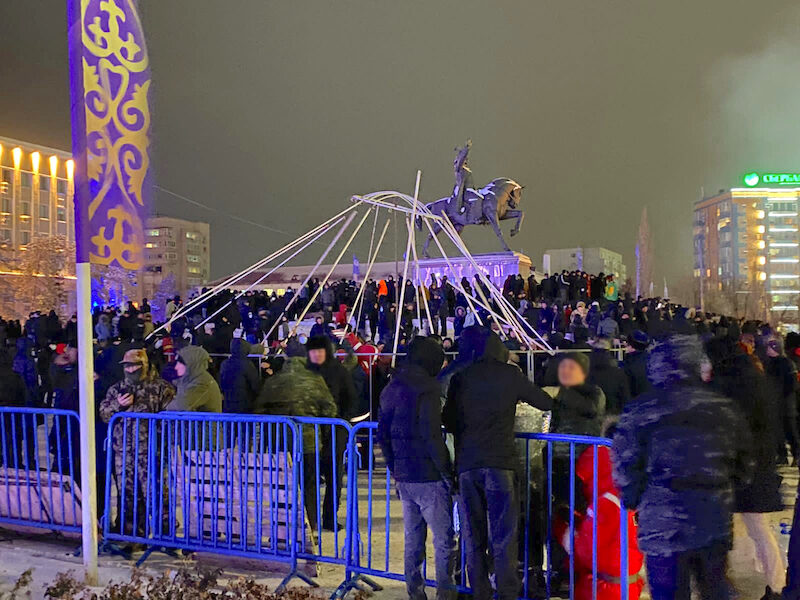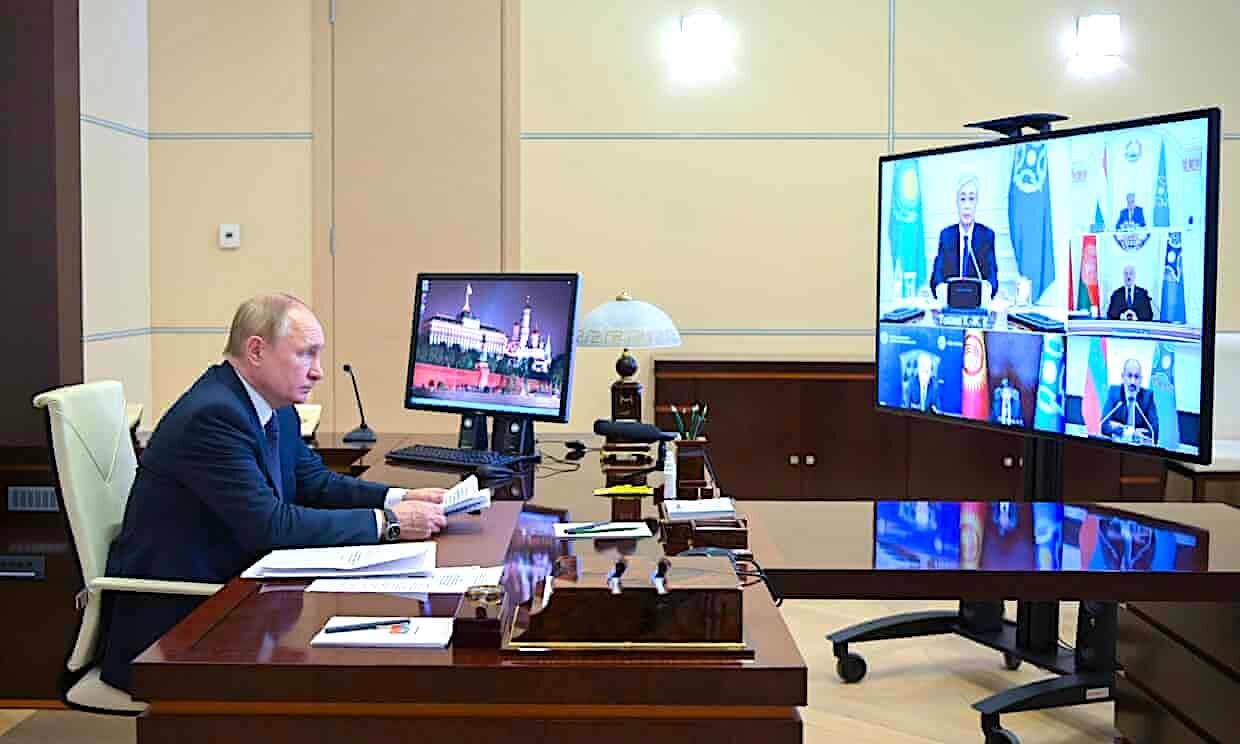
From Above. If the targeted leader has been democratically elected and enjoys popular support, the C.I.A. has worked with elite groups, such as the military, to overthrow him (sometimes through assassination). Among several examples is the first C.I.A-backed coup d'état, on March 30, 1949, just 18 months after the agency's founding, when Syrian Army Colonel Husni al-Za'im overthrew the elected president, Shukri al-Quwatli.
The C.I.A. in 1954 toppled the elected President Jacobo Árbenz of Guatemala, who was replaced with a military dictator. In 1961, just three days before the inauguration of President John F. Kennedy, who favored his release, Congolese President Patrice Lumumba was assassinated with C.I.A. assistance, bringing military strongman Mobutu Sese Seko to power. In 1973, the U.S. backed Chilean General Augusto Pinochet to overthrow and kill the democratically-elected, socialist President Salvador Allende, setting up a military dictatorship, one of many U.S.-installed military dictatorships of that era in Latin America under Operation Condor.
From Below. If the targeted government faces genuine popular unrest, the U.S. will foment and organize it to topple the leader, elected or otherwise. 1958-59 anti-communist protests in Kerala, India, locally supported by the Congress Party and the Catholic Church, were funded by the C.I.A., leading to the removal of the elected communist government. The 1953 coup in Iran that overthrew the democratically-elected Prime Minister Mohammad Mosaddegh was a combination of bottom-up C.I.A. (and MI-6)-backed street protests, and top-down conservative clergy and military to destroy democracy and return a monarch to the throne. The U.S.-backed Ukrainian coup of 2014 is the latest example of the U.S. working with genuine popular dissent to help organize and steer the overthrow, in this case, of an OSCE-certified elected president.
Through Military Intervention. If a coup is not feasible, the U.S. turns to indirect or direct military intervention. One of earliest examples was the U.S. expeditionary force that invaded Russia in 1918 during the civil war in an attempt to help overthrow the new Bolshevik government. More recently, in 1983 the U.S. military invaded Grenada to overthrow a Marxist president; in 1989 the U.S. invaded Panama to overthrow former C.I.A. asset Manuela Noriega.
Another hybrid operation was the U.S. bombing of Serbia in 1999 and the State Department funding of the opposition group Otpor!, which led to the ouster of Slobodan Milosevic. The most prominent recent examples of direct military invasion to overthrow governments are the U.S.-led invasions of Afghanistan in 2001 and Iraq in 2003. Indirect military intervention through proxies to overthrow governments happened in the 1980s Contra war against Nicaragua; and the 2011 to present jihadist war to overthrow the Syrian government.
Not From Thin Air
Economic sanctions are commonly imposed by the U.S. in advance to "soften up" the target.
In non-military interventions, the U.S. does not create regime change out of whole cloth: it works with pre-existing dissent, whether in the population or in the military or another elite group. It will harness it, fund it, train it and organize it, but not create it.
In other words, in regime change that doesn't involve invasion and occupation, it is not a question of either U.S. involvement or genuine dissent. It is almost always both.
And sometimes a cigar is just a cigar: there are legitimate revolts that are not taken over by the U.S. because the uprisings are against U.S. clients' and Washington's interests: for instance, the 2010 uprising in Bahrain. In such cases the U.S. will support crushing dissent (as it is ready to do at home as well).
Kazakhstan
Last week, Consortium News ran two pieces on the uprisings in Kazakhstan. The first, by Craig Murray, made the argument that the C.I.A. was not involved and that the uprising was genuine, given the country's economic inequality and increases in fuel prices that were quickly reversed.
Murray is a former British ambassador to neighboring Uzbekistan and knows Central Asia. There is no doubt that inequality, the fuel price hikes and decades of authoritarian rule fueled the protests. But by its very covert nature, it is close to impossible to know what the C.I.A. is up to anywhere in the world until declassification of documents usually decades later, or if a whistleblower or leak emerges earlier.
Anyway, the C.I.A. did not need to be directly involved. It's been known since at least a 1991 Washington Post article that the C.I.A. is ostensibly no longer required for regime change. After the 1975 Church Committee revelations of its crimes and corruption, the C.I.A., facing a public backlash, resorted to new methods. The establishment of the U.S. National Endowment of Democracy in 1983 does openly what the C.I.A. once did secretly, the Post argued. "The old era of [C.I.A.] covert action is dead," Post columnist David Ignatius declared.
But as CN founder Robert Parry explained in an 2015 article republished today on Consortium News, the C.I.A. had a direct hand in the establishment of the NED, even in the writing of the Congressional legislation that authorized the U.S. Agency for International Development to fund it with U.S. government money. The continued hand of the C.I.A. was to be hidden in the "Age of Overt Action.""The world doesn't run in secret anymore. We are now living in the Age of Overt Action. ... the triumph of overt action [is] a network of overt operatives who during the last 10 years have quietly been changing the rules of international politics. They have been doing in public what the CIA used to do in private — providing money and moral support for pro-democracy groups, training resistance fighters, working to subvert communist rule. And, in contrast to many of the CIA's superannuated Cold Warriors, who tended to get tangled in their webs of secrecy, these overt operatives have been immensely successful."
The NED in Kazakhstan
Since Kazakhstan's independence in 1990 after the breakup of the Soviet Union the country has been run by one man, Nursultan Nazarbayev. Though he formally stepped down in 2019 in favor of his hand-picked successor, Kassym-Jomart Tokayev, Nazarbayev is still the power behind the throne. Nursultan, the new capital city, was named after him in 2019.
Kazakhstan's political system has few democratic features. Not that that matters much to the United States. In its long history of overthrowing governments abroad, the U.S. has toppled dictators just as readily as elected democrats. It is immaterial. What matters is whether leaders are furthering or standing in the way of U.S. interests.
The lack of democracy was of no interest either to former President Bill Clinton and former Prime Minister Tony Blair, who both cozied up to Nazarbayev for lucrative paydays. London and other Western centers have little problem taking investments from undemocratic Kazakh elites.
The lack of democracy in Kazakhstan could be useful to Washington. The population's rage at being suppressed politically and economically is the kind of raw material needed to drive a coup from the bottom up.
In 2020, the NED spent $1,082,991 on 20 programs in Kazakhstan. One was $50,000 to "promote freedom of peaceful assembly" through "strategic litigation to support activists facing repression." Another, for $65,000 was to "promote civic engagement among youth in Kazakhstan."
Genuine Kazakh Revolt
This money was poured into a country with pre-existing tensions that exploded from Jan. 2 to Jan. 11, leaving 227 people dead, 9,900 arrested and vast sections of city centers looted and destroyed.
At the start the government tried to quell the protests by again capping fuel prices, the government resigned and Nazarbayev stepped down as chairman of the national security council. It didn't work. Shoot to kill orders were issued against the rioters.
Ultimately, Russian troops as part of the Collective Security Treaty Organization mission restored order. In a news analysis on Jan. 6, The New York Times Eastern Europe bureau chief made an unattributed, editorial comment: "And once Russian troops arrive, they seldom, if ever, go home." Normally the corporate media are fed such lines by unnamed U.S. officials. In this case the U.S. government line seemed to work in reverse.
The next day U.S. Secretary of State Antony Blinken said, "One lesson of recent history is that once Russians are in your house, it's sometimes very difficult to get them to leave."
Moscow reacted furiously, pointing out that the U.S. should examine its history of the invasions of Vietnam and Iraq. ""If Antony Blinken loves history lessons so much, then he should take the following into account: when Americans are in your house, it can be difficult to stay alive and not be robbed or raped," the foreign ministry said.
The Russian and other CSTO troops left Kazakhstan on Wednesday.
US Interests in Kazakhstan
Installing a government hostile to Russia and China, which both border Kazakhstan, would be advantageous to the U.S. It could disrupt China's Silk Roads initiative through the country and the U.S. could put a military base in Kazakhstan. Since April the U.S. has been trying to find a Central Asian country for a base to further the encircling pressure on Russia. There are also oil and gas deposits beckoning.
Despite these interests, the second article that Consortium News ran last week advised the U.S. stay out of Kazakhstan. Saying there was no evidence of U.S. involvement with the protests, Anatol Lieven wrote:
Circumstantial Evidence of the Causes"If the Kazakh government collapses or is gravely weakened, it would be very surprising if hard line elements in Washington did not see this as an opportunity to use Kazakhstan as a base to undermine Chinese rule in Sinkiang — even if (as in Syria) this led them into de facto alliance with Islamist extremist forces.
For America to use Kazakhstan in this way would be both a crime and a blunder, that would recall the worst aspects of U.S. policy in Africa, Asia, and Central America during the Cold War. It would in fact cast America in the role in which American commentators like to cast Russia — that of a cynical troublemaker, absolutely indifferent to the consequences of its actions for unfortunate populations on the ground."
Was in fact the U.S. not involved in the uprising, as Lieven maintains?
According to Russian President Vladimir Putin, "The events in Kazakhstan are not the first and far from the last attempt to interfere in the internal affairs of our states from the outside." He told other CSTO leaders on Jan. 10: "The measures taken by the CSTO made it clear that we would not let anyone destabilize the situation at our home and implement so-called 'color revolution' scenarios."
Putin also said, "Elements of force and information support of protests were actively used, and well-organized and well-controlled groups of militants were also used ... including those who had obviously been trained in terrorist camps abroad."
The possible presence of jihadists followed reports that a Kazakh policemen had been beheaded.
The Kazakh government had a slightly different take, according to long-time Moscow correspondent Fred Weir, writing in the Christian Science Monitor:
Normally in regime change operations, the U.S. has a leader in exile ready to be installed. Mukhtar Ablyazov, leader of the Democratic Choice of Kazakhstan, is in exile in Paris. He says he has not accepted Western money, asked for Western sanctions, which have not come, and egged on what he called the revolution unfolding in his country. He claimed Russia was "occupying" Kazakhstan, only to see the uprising end and Russian troops leave."Kazakh leaders have offered a different explanation, pointing to high-ranking internal traitors who utilized the pretext of price increases to trigger protests, then unleashed specially trained armed units in an attempt to stage a coup d'état. At least one top former official, the recently dismissed head of the security services, Karim Masimov, has been arrested and charged with plotting against the state.
Other experts note that no movement has claimed responsibility for the uprising, and no set of unified demands or discernible leaders have emerged from the turmoil. That highly unusual circumstance is hard to square with an organized rebellion, Galym Ageleulov, head of the independent human rights group Liberty, told the Monitor from Almaty on Monday.
'I think what happened was that a peaceful civil meeting of people who are tired of authoritarian government got used by elites in their internal struggles,' he says. 'It was a spontaneous upsurge without leaders because there is no permitted legal opposition, and civil activism is not able to grow.' ...
'All the elements are there: socioeconomic tensions, elements of outside interference, and a half-completed transfer of power' from the aging autocrat Mr. Nazarbayev to his chosen successor, Mr. Tokayev, [Fyodor Lukyanov, a leading Russian foreign policy analyst] says. "'It is well known that some groups behind Nazarbayev were not happy with his choice. There is a feeling among many observers that it was not a purely spontaneous outburst.'"
The beheadings, the organized nature of the uprising, the seizing of the airport, the NED funding, and the leader in exile are all circumstantial evidence of possible U.S. involvement. Many commenters on social media and on this site took the view that if it walks like a duck, it must be a U.S.-backed coup.
But journalism needs to be held to a higher standard of proof. CN rightly criticizes corporate media for repeating unnamed U.S. intelligence officials without skepticism. Skepticism must also be applied when the U.S. is accused of being involved in a coup. Circumstantial evidence is not enough. Even in an "Age of Overt Action" a smoking gun is needed, usually arriving with the declassification of documents that has proved the history of U.S. regime change.
In 2014 in Ukraine, there was also the circumstantial evidence of NED involvement. Then U.S. Assistant Secretary of State for European and Eurasian Affairs Victoria Nuland told the U.S.-Ukrainian Foundation on Dec. 13, 2013, that Washington had spent $5 billion over a decade to support Ukraine's "European aspirations," in other words to pull it away from Russia.
But there was also a smoking gun. It came in the form of the leaked telephone call between Nuland and the then U.S. ambassador to Ukraine in which they discussed who the new Ukrainian leader would be, weeks before the coup occurred.
In Kazakhstan, despite the circumstantial evidence, there is no smoking gun so far. Therefore the question of whether there was direct and decisive U.S. involvement in the Kazakh uprising must remain inconclusive.
Joe Lauria is editor-in-chief of Consortium News and a former U.N. correspondent for The Wall Street Journal, Boston Globe, and numerous other newspapers. He was an investigative reporter for the Sunday Times of London and began his professional work as a 19-year old stringer for The New York Times. He can be reached at joelauria@consortiumnews.com and followed on Twitter @unjoe






Houston Stewart Chamberlain The Foundations of the Nineteenth Century (Die Grundlagen des neunzehnten Jahrhunderts, 1899)
THE REAL FATHER OF NAZISM
Then:
Joseph Arthur de Gobineau
Alfred Rosenberg
Josiah Clark Nott
Henry Hotze
Alexandru C. Cuza
etc.............
Hitler was just a Puppet of those FOOLS ,
Today, we could see, that are still many, many, many followers in the USA and not ONLY, of those doctrines.